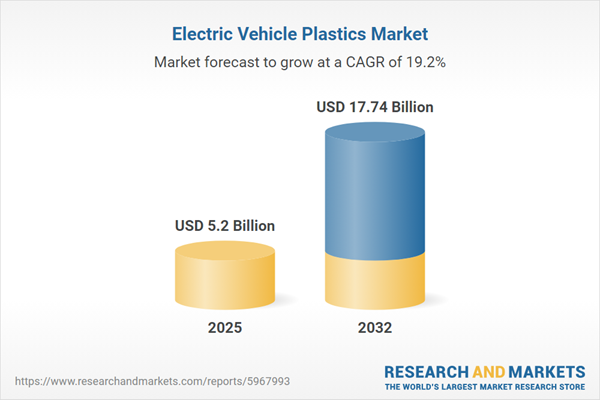Speak directly to the analyst to clarify any post sales queries you may have.
Senior executives face transformative challenges in the electric vehicle plastics market as sustainability requirements, innovation cycles, and shifting regulations redefine how materials are sourced and operations are structured. To succeed, leadership must make informed decisions with actionable insights that drive operational resilience and adaptability in a globally interconnected automotive environment.
Market Snapshot: Growth and Business Transformation in the Electric Vehicle Plastics Market
The electric vehicle plastics market exhibits steady expansion as the shift from combustion engines to electric mobility continues worldwide. Companies are responding to sector trends by introducing advanced polymers that improve structural integrity while reducing overall vehicle weight. These materials play a central role as design priorities pivot towards energy efficiency, reflecting a broader industry movement toward sustainable transport solutions. Changes in global regulatory dynamics are leading manufacturers to enhance compliance protocols and evolve sourcing strategies. This environment encourages cross-functional collaboration, driving innovative business models that enable organizations to adapt at varying rates across international markets.
Scope & Segmentation of the Electric Vehicle Plastics Market
- Polymer Types: Includes PC ABS blends, polyamides (PA6, PA66), homopolypropylene, copolypropylene, polyurethanes, and thermoplastic elastomers. These polymers provide durability, electrical insulation, and effective heat management for evolving vehicle architectures.
- Applications: Used in battery housings, insulation parts, dashboards, seats, under-hood components, trims, and door assemblies. These features help manufacturers meet safety standards, regulatory compliance, and efficiency targets.
- EV Types: Polymer innovations are integral to battery electric vehicles, standard hybrids, and plug-in hybrids, supporting tailored designs for both passenger and commercial vehicle segments.
- Vehicle Categories: Advanced plastics are found in light-duty passenger vehicles, commercial trucks, and specialized mobility solutions. Each category presents unique durability requirements and performance needs.
- Production Processes: Injection molding, extrusion, blow molding, and thermoforming support scalable and precise vehicle component manufacturing, allowing companies to align with automotive quality and regulatory benchmarks.
- End Use Sectors: Both original equipment manufacturers (OEMs) and aftermarket participants rely on plastics for rapid product launches, robust supply chains, and effective value delivery across platforms.
- Regions Covered: The Americas, Europe, Middle East & Africa, and Asia-Pacific introduce region-specific regulatory frameworks and technology adoption patterns, requiring organizations to adjust sourcing and innovation strategies to local market demands.
- Key Companies Profiled: Major suppliers such as BASF SE, Covestro AG, Saudi Basic Industries Corporation, LyondellBasell Industries N.V., Dow Inc., DuPont de Nemours, Inc., Evonik Industries AG, LANXESS AG, Celanese Corporation, and Koninklijke DSM N.V. are continuously developing new polymer portfolios that align with changing electric vehicle requirements.
Key Takeaways: Strategic Insights for Senior Leaders
- Flexible plastics and modular assembly facilitate adaptation to emerging consumer requirements and the evolving spectrum of international regulations.
- Recycled and bio-based polymer use enables organizations to advance lifecycle sustainability while addressing increasing environmental performance expectations across value chains.
- Collaboration between polymer suppliers and automotive manufacturers expedites the customized development of materials that address mission-critical safety and operational needs.
- Integrated digital solutions within manufacturing and sourcing operations improve supply chain transparency and streamline compliance management in complex multi-vendor ecosystems.
- Adopting nearshore or regional sourcing models increases agility and mitigates supply chain disruptions, fostering continuity during regulatory and market shifts.
- Advanced simulation and compounding techniques help improve battery protection and enhance cabin features, reinforcing ongoing vehicle platform innovation.
Tariff Impact: Navigating Policy Changes in the United States
Forthcoming trade policy adjustments in the United States are anticipated to impact input costs for key polymers, such as polyamides and thermoplastic elastomers. Leading manufacturers are addressing these challenges by reinforcing domestic certification programs, exploring production zones that are exempt from tariffs, and broadening their supplier bases. These strategies aim to maintain supply chain stability and manage risks linked to policy-driven financial fluctuations.
Methodology & Data Sources
This report is grounded in expert input from polymer engineers, automotive industry specialists, and supply chain practitioners. The analysis includes evidence from facility audits, regulatory assessments, direct expert interviews, patent reviews, and field-based market intelligence, ensuring a robust informational foundation for executive decisions in the sector.
Why This Report Matters: Actionable Value for Decision-Makers
- Enables leadership teams to proactively address regulatory uncertainty and operational complexity in the electric vehicle plastics market.
- Delivers targeted intelligence on emerging polymer technologies and strategic sourcing practices to drive enterprise transformation and process optimization.
- Provides region-specific recommendations to help decision-makers identify new opportunities and strengthen competitive positioning in the global electric mobility market.
Conclusion
With regulatory landscapes and mobility requirements in constant flux, senior leaders equipped with timely, actionable intelligence can anticipate market shifts and secure sustainable business advantages in the electric vehicle plastics market.
Additional Product Information:
- Purchase of this report includes 1 year online access with quarterly updates.
- This report can be updated on request. Please contact our Customer Experience team using the Ask a Question widget on our website.
Table of Contents
3. Executive Summary
4. Market Overview
7. Cumulative Impact of Artificial Intelligence 2025
Companies Mentioned
The companies profiled in this Electric Vehicle Plastics market report include:- BASF SE
- Covestro AG
- Saudi Basic Industries Corporation
- LyondellBasell Industries N.V.
- Dow Inc.
- DuPont de Nemours, Inc.
- Evonik Industries AG
- LANXESS AG
- Celanese Corporation
- Koninklijke DSM N.V.
Table Information
| Report Attribute | Details |
|---|---|
| No. of Pages | 180 |
| Published | November 2025 |
| Forecast Period | 2025 - 2032 |
| Estimated Market Value ( USD | $ 5.2 Billion |
| Forecasted Market Value ( USD | $ 17.74 Billion |
| Compound Annual Growth Rate | 19.2% |
| Regions Covered | Global |
| No. of Companies Mentioned | 11 |









